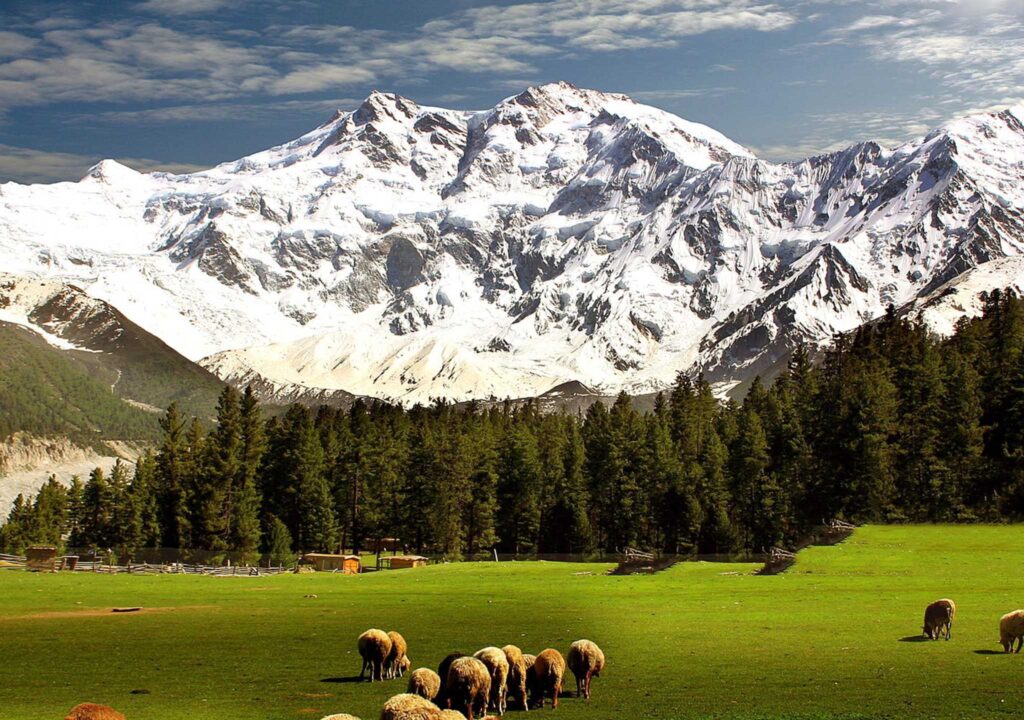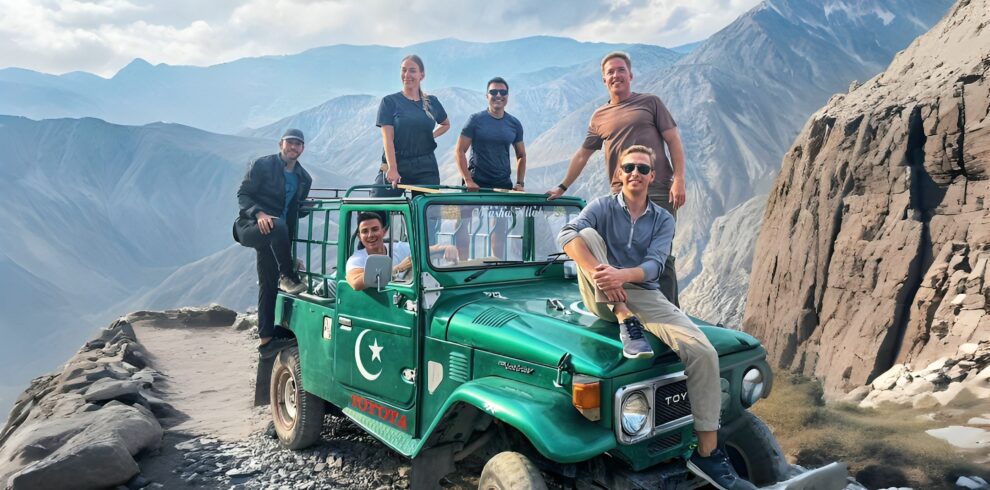Standing tall at 8,126 meters (26,660 ft), Nanga Parbat is Pakistan’s pride and one of the most challenging mountains in the world. Known as the “Killer Mountain” for its deadly climbing history, it rises dramatically above the Indus Valley in Gilgit-Baltistan. This mighty peak is part of the Himalayan range, and its breathtaking beauty attracts trekkers, climbers, and nature lovers from around the world.
Nanga Parbat History & Name Origin
The name “Nanga Parbat” comes from Sanskrit, meaning “Naked Mountain”, due to its enormous, bare rock faces that rise sharply without much vegetation. Locally, it is called “Diamir”, which means King of Mountains.
Historically, Nanga Parbat became infamous during the early days of Himalayan exploration. The first attempts to climb it were made by German expeditions in the 1930s. Due to avalanches, harsh weather, and difficult terrain, many climbers lost their lives, earning it the nickname “Killer Mountain”.
The first successful ascent was made by Hermann Buhl (Austria) in 1953, achieved solo and without oxygen — one of the greatest feats in mountaineering history.
Technical Facts about Nanga Parbat
- Height: 8,126 meters (26,660 ft) – 9th highest in the world and 2nd highest in Pakistan.
- Location: Gilgit-Baltistan, Pakistan.
- Range: Western Himalayas.
- Coordinates: 35°14′14″N 74°35′21″E.
- Prominence: 4,608 meters (15,118 ft).
- Base Camp Altitude: Around 3,500 meters (11,500 ft).
- Climbing Difficulty: Considered one of the most dangerous 8000-meter peaks in world.
- Routes: Three main faces – Rupal Face (world’s largest mountain face), Diamir Face, and Raikot Face.
3d Map of Nanga Parbat
Nanga Parbat Location
It is located in the western Himalayas, at the western edge of the Gilgit-Baltistan region, near Diamer District, and lies close to the Indus River. Due to its sheer rise from the surrounding terrain, it is often called the “Killer Mountain.”
Nanga Parbat Climbing Routes
The mountain has several climbing routes, with the Rupal Face on the south side being the world’s tallest mountain face, rising about 4,600 meters from base to summit. On the north side lies the Diamer Face, which is considered the standard route and has been the most commonly used for successful ascents. The Raikot Face, accessible from Fairy Meadows, is another route known for its breathtaking views but extreme difficulty. Climbers from around the world attempt Nanga Parbat mainly through the Diamer route, which, although less technical compared to others, still poses severe challenges due to avalanches, harsh weather, and unpredictable conditions.
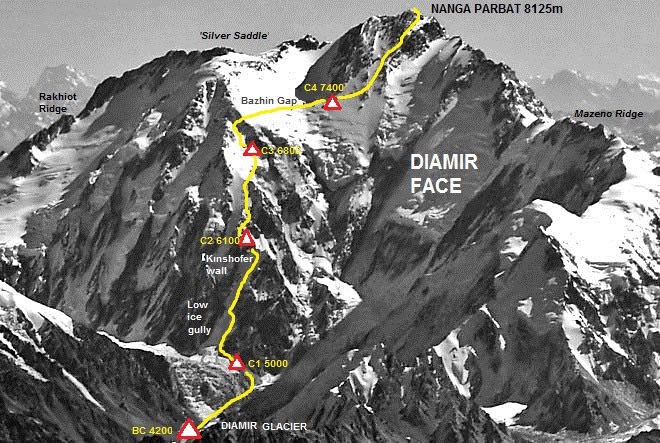
All Climbing Routes
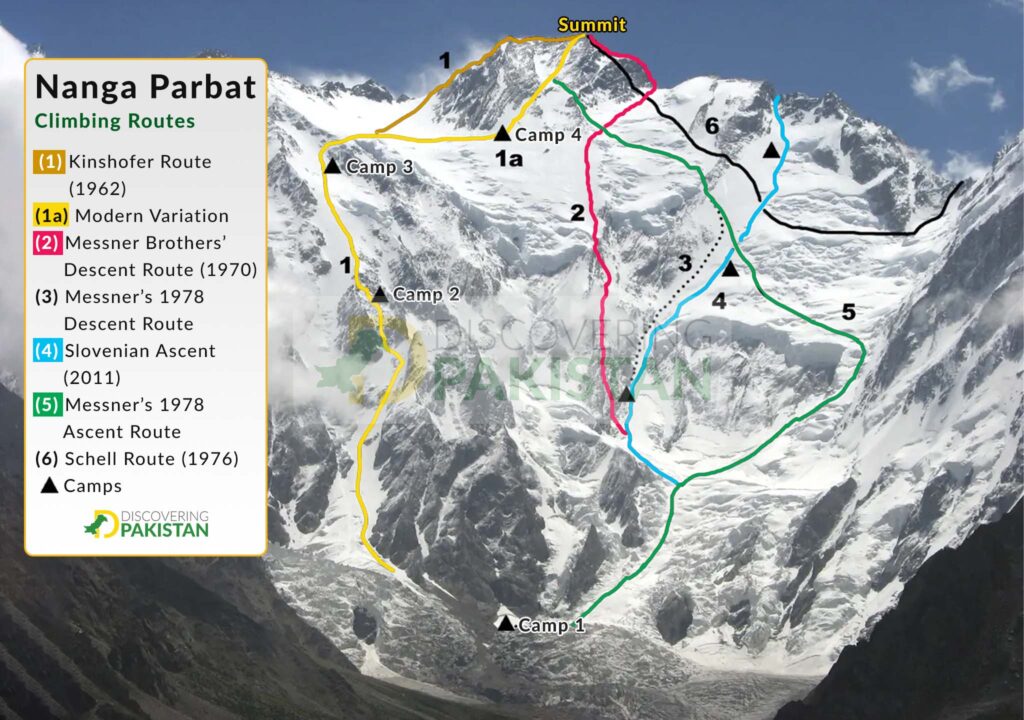
(1) Kinshofer Route (1962)
- First established successful line on the Diamir Face.
- Became the classic and most popular route, used for the majority of modern ascents.
(1a) Modern Variation of Kinshofer Route
- Climbers usually follow this slightly modified line today.
- Considered the standard route due to relatively “safer” terrain compared to other faces.
(2) Messner Brothers’ Descent Route (1970) – Mummery Rib
- Famous due to the tragic descent of Reinhold and Günther Messner.
- Historically important as it sparked decades of debate in mountaineering history.
(3) Messner’s 1978 Descent Route
- Taken by Reinhold Messner during his solo ascent year.
- Highlights his pioneering spirit and shows alternative ways down the Diamir Face.
(4) Slovenian Ascent (2011) – Upper Southwest Ridge
- Showed modern climbers’ willingness to push for new variations.
- Added to the evolving climbing history of the mountain.
(5) Messner’s 1978 Ascent Route
- The line of Reinhold Messner’s legendary solo ascent, the first time Nanga Parbat was climbed alone without supplemental oxygen.
- A milestone in high-altitude mountaineering.
(6) Schell Route (1976) – Rupal Flank to Mazeno Col
- A massive, long, and demanding line.
- Known as one of the most complex and challenging routes, with several variants developed later (e.g., Ronald Naar’s 1981 traverse).
Culture & People around Nanga Parbat
The areas surrounding Nanga Parbat are home to Shina-speaking and Balti communities, known for their warm hospitality. Villages like Tato, Fairy Meadows, and Diamir Valley provide insight into the local way of life. The people live simple, self-sufficient lives, relying on agriculture, livestock, and tourism.
Attractions & Highlights
- Fairy Meadows: A lush green alpine meadow at 3,300m, offering spectacular views of Nanga Parbat’s north face.
- Rupal Face: The highest mountain face in the world (4,600m vertical rise).
- Raikot Glacier: A scenic glacier trek accessible from Fairy Meadows.
Fairy Meadows
Fairy Meadows is a lush green alpine meadow located at the base of Nanga Parbat in Gilgit-Baltistan, Pakistan. Situated at an altitude of about 3,300 meters, it offers breathtaking views of the mountain’s Raikot Face and is regarded as one of the most beautiful camping sites in the world. The area can be reached by a jeep track from Raikot Bridge on the Karakoram Highway, followed by a short trek. Fairy Meadows serves as the gateway for trekkers heading towards Nanga Parbat’s base camp, while also attracting nature lovers who come to enjoy its serene meadows, dense pine forests, and stunning panoramas.
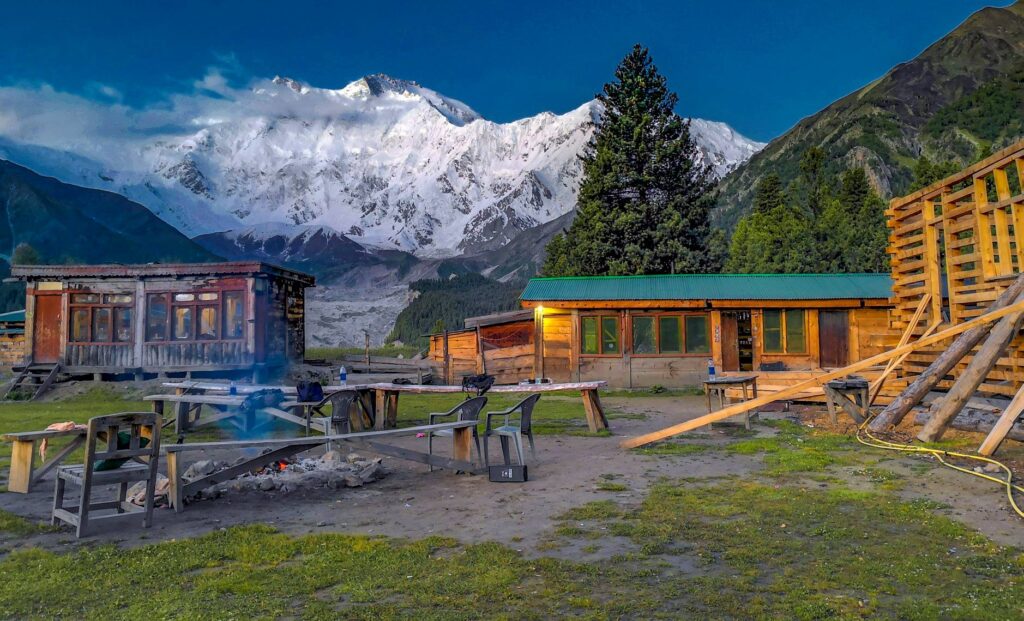
Nanga Parbat and the Messner Controversy
Nanga Parbat is not only famous for its beauty but also linked to one of the most tragic chapters in mountaineering history. In 1970, the legendary Italian climber Reinhold Messner attempted Nanga Parbat with his younger brother Günther Messner. After successfully summiting via the Rupal Face, the brothers descended on the Diamer side, which was unplanned and extremely dangerous. During this descent, Günther was killed, reportedly swept away by an avalanche near Fairy Meadows.
The incident sparked a decades-long controversy. Reinhold Messner claimed that he had no choice but to descend the Diamer Face due to exhaustion and worsening weather, insisting that Günther followed him willingly. However, some expedition members accused him of abandoning his brother to achieve personal glory. The debate became one of the most heated disputes in mountaineering history.
Years later, remains identified as Günther’s were found on the Diamer side, confirming Reinhold’s account that his brother had indeed perished during the descent. Fairy Meadows, therefore, is remembered not only for its scenic wonder but also for this emotional and controversial chapter in the conquest of Nanga Parbat. Full Story Here…
Deaths on Nanga Parbat
Nanga Parbat has a tragic reputation in mountaineering history and is often called the “Killer Mountain” because of the high number of climbers who lost their lives attempting it. Before the first successful ascent in 1953 by Hermann Buhl, more than 30 climbers had already died, most of them on the German expeditions of the 1930s. The mountain’s steep faces, frequent avalanches, unpredictable weather, and long climbing routes make it one of the most dangerous 8,000-meter peaks in the world.
Over the decades, many famous tragedies have taken place here, including the 1934 German expedition disaster and the 1970 Messner brothers’ climb where Günther Messner died. Even in recent years, deaths continue to occur, keeping Nanga Parbat among the deadliest peaks in the Himalayas.
Tours to Nanga Parbat
This tour begins in Islamabad, Travel to Raikot Bridge by road via KKH. Then additional 2 hours jeep ride and 3 hours trekking to reach Fairy Meadows. Trek to Nanga Parbat BC for a full day trekking experience.
This 7-day Fairy Meadows tour combines Hunza Valley's culture with an unforgettable trek to Nanga Parbat's base camp, featuring some of Pakistan's most breathtaking mountain scenery.
This 14-day tour starts in Islamabad with a flight to Skardu. You explore Skardu, then travel to Hunza and Fairy Meadows. After returning to Islamabad by air, you visit Khewra Salt Mines on the way to Lahore, where the tour ends.
Frequently Asked Questions (FAQs)
Where is Nanga Parbat located?
Nanga Parbat is located in Gilgit-Baltistan, Pakistan, at the western end of the Himalayas near the Indus River.
What is the height of Nanga Parbat?
The height of Nanga Parbat is 8,126 meters (26,660 feet), making it the 9th highest mountain in the world.
Why Nanga Parbat is called Killer Mountain?
Nanga Parbat is called the Killer Mountain because in the early years of climbing many mountaineers died due to avalanches, harsh weather, and dangerous terrain.
Who climbed Nanga Parbat first?
Hermann Buhl of Austria climbed Nanga Parbat first on July 3, 1953, via the Rakhiot Face, without supplemental oxygen.
How many people climbed Nanga Parbat?
Over 400 climbers have successfully climbed Nanga Parbat so far, but it remains one of the most difficult 8,000m peaks.
How to get to Nanga Parbat?
To get to Nanga Parbat, most visitors go through Fairy Meadows. From Islamabad, travel to Raikot Bridge on the Karakoram Highway, take a jeep to Tato Village, then hike to Fairy Meadows and continue to Nanga Parbat Base Camp.
